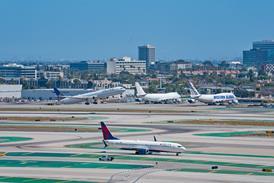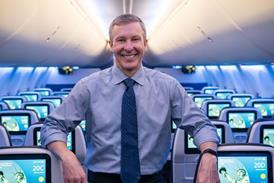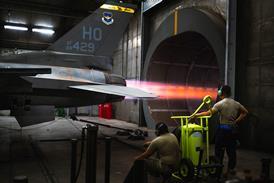Faced with a host of restrictions, the European business aviation community is striking out
Kate Sarsfield/LONDON
The European business aviation industry is pushing the boundaries. In a quest to demonstrate the growing stature of business aviation in the region, the continent's biggest ever dedicated business aviation event will be held in Geneva, Switzerland, between 18-24 April.
"The European Business Aviation Convention and Exhibition (EBACE) is designed to draw in manufacturers, operators and, importantly, regulators; and demonstrate the commercial and economic benefits of this burgeoning method of transportation," says Brian Humphries, chairman of the European Business Aviation Association (EBAA), an organisation which represents the interests of 150 members.
EBAA's involvement with NBAA has drawn its critics, however, who fear the European association will be swallowed up by the US-based giant. An industry source said: "EBACE is simply NBAA on steroids. It is trying to be another NBAA show but it won't work. EBAA should concentrate on what it does best and stick with its normal [small] conference format".
EBAA dismisses its detractors insisting that the annual conference, "an invaluable forum for the industry", will continue. Humphries responds: "It is time Europe hosted its own business aviation convention to reflect the growing importance of this region - the largest business aircraft market outside North America. Although our industry has made great strides in the past decade, there are still a number of fundamental issues which need to be addressed. Only by demonstrating the qualities of business aviation can a robust market prevail."
Jack Olcott, NBAA president agrees: "There are more than 2,000 turbine-powered business aircraft in Europe and the fleets are undergoing a radical transformation. Although in recent years there has been a shift in attitude towards business aircraft, in terms of acceptance, the industry is at least a decade behind the USA."
Access rights
EBAA admits its priority is "fair and equal access to the regions' airspace and airports" and is seeking to address these issues through representation, where possible, in the regulatory decision making process.
The Brussels-based association says: "Congestion in European airspace and at its many airports has reached a critical stage that severely affects the value of business aviation to national and local economies."
Airports Council International forecasts traffic growth at around 5% across its European member airports. Preliminary results for 2000 reveal that 263 of its 300-plus members have recorded a combined total of 16.8 million movements. The final tally, to be published in May, "will be much higher", says the Geneva-based organisation.
Meanwhile, as lucrative airlines expand their fleets and a crop of new low-cost carriers emerge at the secondary airports, further increases will follow.
Capacity constraints at London Heathrow, Europe's busiest hub, have virtually driven out business aviation during peak times. Resident fixed-based operator Metro Business Aviation has been forced to transfer its engineering base to Luton, and Shell Aircraft has elected to move its flight department to Rotterdam. The situation appears to now be worsening at Brussels Zaventem, Frankfurt Airport, Madrid and Amsterdam Schiphol. Humphries concedes: "The very nature of business aviation dictates that it has access to airports served by the airlines, and its passengers often need to connect to scheduled flights."
Eurocontrol, which is responsible for all traffic activities within its 30 member states, predicts the future bottleneck in the European air transportation system will be airports. As part of its Air Traffic Management 2000+ strategy, Brussels-based Eurocontrol is devising and implementing a number of industry-led initiatives to combat these concerns. Current projects include an airport capacity assessment model which evaluates the runway, taxiway and apron capacity at each airport, and uses the information to calculate each one's declared capacity. The data is then translated into useable software that the airports can interpret.
Eurocontrol says: "Currently, the European Union stipulates that all European airports must declare their slot capacity every six months. The new software, which should become available by the middle of next year, once all the validations are complete, should provide a neutral and objective method of evaluating capacity. Consequently it allows airports to operate on a level playing field".
Eurocontrol admits that only the runway module has so far been validated, with Finland's Helsinki, Brussels Zaventem and Portugal's Lisbon providing the test beds.
The association is also monitoring the latest advanced surface movement guidance and control systems, which are designed to "speed up traffic despite inclement weather, and reduce runway incursions".
The agency admits, however, whatever measures are introduced to increase capacity, the airlines will always put their stamp on it first as they have a tangible economic case for doing so. It says: "If an airport is asked to choose between an airliner carrying 400 passengers, most of whom will pass through their facilities to and from the gate, and a business jet carrying six people who are whisked off in a car immediately they step out of the aircraft, the big buck will win every time."
Meanwhile, many business aircraft companies which have chosen to base their operations at secondary airports, for example London's Luton and Stansted, now face an uncertain future because the mass of low cost carriers are moving in and demanding slots. Fordair, Ford Motor's European corporate flight department, has operated a regular charter service during peak hours from Stansted Airport for over thirty years. Yet due to the nature of its operation, it cannot be awarded Grandfather rights or protected status. Such is the demand now for premium slots at London's third busiest airport that Fordair's regular service has been threatened.
The plight of business aircraft operators has received a sympathetic ear from the European Commission (EC), which is also seeking a solution to Europe's deepening slot crisis.
Frederik Sorensen, head of unit for economic regulation and air transport agreement at the EC, says: "Long standing regular charter operators like Fordair and DeBeers' Heathrow-based flight department should be treated like air carriers. A simple proposal for such will be put on the table [at the forthcoming European Council meeting] in June, and I am hopeful that it will be accepted within a year."
For operators of ad hoc charters, however, Sorensen admits the future at Europe's busiest airports is uncertain. He concedes: "A number of suggestions have been put forward, such as allocating a dedicated number of slots to ad hoc operators. But once you introduce positive discrimination you are open to charges of uncompetitive behaviour, so it will never be accepted by the Commission."
Sorensen supports the business aviation community's plea to make available a range of strategically-placed reliever airports across Europe to combat the situation, saying: "There is a clear need to address this issue and there are a number of secondary airports which would be ideal candidates."
For business aircraft designer Farnborough-Aircraft.com, the solution to airport congestion lies in the development of versatile aircraft, built to take off and land from short runways and grass strips. The UK company is developing a single engine turboprop which is targeted at the air taxi market. Called the F1, the aircraft will be designed to operate on runways as short as 430m (1,409ft). Farnborough Aircraft managing director Richard Noble explains: "There are 2071 airfields in Europe of which only 32% have 5,000ft+ runways [suitable for all types of business aircraft], and 148 offer runways of between 4001 and 5,000ft [suitable for smaller types]. Aircraft, such as the F1, could utilise around 80% of the airfields in Europe, and enable operators to bypass the congested airports, thereby freeing-up more capacity."
For Eckhard Seebohm, EU Commissioner for airport planning, the solution to airport congestion is more complicated than Noble suggests. He says: "To develop new airports there has to be certain preconditions in place, such as good ground transportation links to major cities, and infrastructure upgrades."
Such moves, he admits, are likely to be met with a barrage of opposition from local residents, environmental pressure groups and from local and national politicians, each with their own vested interests. Nonetheless, Seebohm concedes: "These issues must be faced if we are to promote the use of reliever airports in a liberal market."
Airspace congestion
While the operators wrestle it out on the ground, a battle is also looming in Europe's skies. According to Eurocontrol, 8.5 million flights were handled last year within the 38 European Civil Aviation Conference (ECAC) states, and this number is forecast to double by 2020.
To find a solution to this potentially catastrophic problem, Eurocontrol has adopted a radical programme for handling the traffic growth, based on improving route network development and utilising new flight levels.
The association admits that all immediate initiatives are aimed at moving as efficiently as possible towards a "One Sky for Europe" concept, forecast for 2005, when national boundaries will disappear. Air traffic management will be further rationalised, possibly with a small number of air traffic control centres (ATC) centres strategically located across the continent.
While EBAA supports Eurocontrol's initiatives, it also fears that certain programmes could impose artificial constraints on the business aircraft user. EBAA argues: "Business aviation is facing the proliferation of technology-led new equipment mandates. [European reduced vertical separation minima, Mode S transponder, 8.33kHz channel spacing, for example). Whilst aimed at increasing capacity, they are also a tremendous financial burden to operators." In the case of RVSM, depending on the size and the age of the aircraft and its static systems, the cost for modification is estimated to be between $7,000 to $425,000 per aircraft.
The industry also stresses the cost of modifying a typical business jet to comply with all the recent entry requirements is not only high but equipment will not be utilised as heavily as on an airliner. It says: "Typically the average business jet flies about 400h a year - an airliner 4,000h."
Implementation of EU RVSM, on 24 January 2002, is of immediate concern to the flying community. An extension of the North Atlantic (NAT) RVSM, which was implemented in March 1999, it is designed to give operators more freedom, increase capacity and reduce delays, by reducing minimum vertical separation between aircraft from 2,000ft (610m) to 1,000ft. NAT RVSM falls between flight levels FL310 and FL390. In Europe, the RVSM airspace will fall between FL290 and FL410 and include six new levels. Aircraft which have failed to receive operational approval by the EU RVSM deadline will be unable to fly in these upper flight levels and will instead be restricted to FL280 and below.
While the bulk of new generation aircraft are now RVSM approved, older aircraft - such as the Raytheon HS125 series, Cessna Citation 500 series, Bombardier Learjet 30 series and Dassault Falcon 10 - are not says EBAA.
The situation has alarmed both Eurocontrol and operators of these types who have been given no time scale from their manufacturers for estimated service bulletins for their models . EBAA asserts: "There is simply no commercial incentive for the manufacturers to issue a service bulletin [for these aircraft] as there are relatively small numbers flying in Europe."
Eurocontrol admits that "large numbers" of aircraft did not meet its EU RVSM safety case deadline of 31 March, which, although not enforceable, was designed to satisfy the agency that fleet compliance was sufficiently widespread to make implementation viable. The go/delay decision will be made in July.
JAR regulations
The barrage of regulations forced upon the business aircraft community sees no sign of abating. While the Joint Aviation Authorities has already caught the commercial operators, such as fractional ownership and charter companies, in its regulatory net, under the auspices of JAR OPS 1 (soon to be incorporated into European law under EU-OPS 1), its sights are now focussed on the non-commercial operations. This covers corporate aircraft, including company flight departments and aerial work aircraft, defined as "operations in which an aircraft is used for specialised services such as agriculture, construction photography, search and rescue, and aerial advertising."
Requirements for these operations are being developed by the aerial work and general aviation sub-committee (AWGAS), which is part of the JAA operations committee. AWGAS includes the European Business Aviation Association, the European Council of General Aviation Support (ECOGAS), the National Business Aviation Association plus members of National Aviation Authorities (NAAs).
The industry proclaims: "We are not asking for a watered down version of JAR-OPS 1, but a set of requirements which reflect the nature of corporate aircraft and aerial work operations."
Although AWGAS has yet to agree on a definition for corporate aviation, it is hoping to present a generic draft of JAR OPS 2 to the JAA Ops Committee shortly. The draft, roughly summarised, is expected to recommend that aerial work operators obtain "certification" by their NAAs, while corporate flight departments undergo "registration". In both cases, an operations manual will form the basis for JAR-OPS 2 implementation, which could be based on the International Business Aviation Council (IBAC) International Standards for Business Aircraft Operations (ISBA-O) document. A final draft will be presented at EBACE.
Montreal-based IBAC, the umbrella association for nine worldwide trade associations, has been working on the ISBA-O best-practice document as the foundation for a generic operations manual that will be acceptable to the JAA and its member NAAs.
Common standards
ISBA-O was launched last year, following pleas from the international business aircraft community for the creation of workable, common-baseline operating standards across the industry, and which incorporate equipment, maintenance and procedural requirements.
Don Spruston, IBAC's director-general, admits: "Notwithstanding ICAO's standards and recommended practices [on which ISBA-O is closely aligned], one of the most significant aviation issues is the lack of harmonised international operation procedures. No common baseline exists for measuring a good operation and for helping new operators to develop a high standard." Spruston is keen for the JAA to take a lead and adopt ISBA-O as the basis for JAR-OPS 2. He admits: "Regulators wrestling with the consequences of rapid growth could develop new regulations in an inequitable way because they do not have an understanding of business aircraft operations.
Image constraints
While Europe's business aviation community wrestles with existing and pending regulatory and technological changes, the battle for a positive image continues to rage, and it remains a key obstacle to growth. The tarnished perception of business aircraft as executive toys prevails, although the industry insists the concept is now dead. EBAA's Humphries, who is also managing director of Shell Aircraft, says: "Business jets have become an essential working tool for many companies. They offer the user flexibility, convenience and time saving, thereby increasing productivity." Like most companies, Shell's aircraft are used for tight schedules or for flights not serviced by the airlines.
NBAA's Olcott says: "The image issue is hard to tackle. In the USA, business aviation is popular because it represents the embodiment of the American entrepreneurial spirit. In Europe, the image is steeped in scepticism and conservatism. If there was a change of attitude in Europe, business aircraft could be very, very popular."
Executive Jet, owner of NetJets, the world's largest fractional ownership programme, compounds Olcott's theory. In the six years since NetJets Europe was established, its customer base has grown to around 150.
"Europe has been a tough nut to crack and I must admit growth in the region has been slower than I expected," says Executive Jet chairman and chief executive Richard Santulli. The fractional ownership pioneer blames the negative image of business aircraft has contributed to the slow take-up rate.
In a recent move to stimulate interest in the programme, Warren Buffett, financier and owner of Executive Jet through his Berkshire Hathaway corporation, conducted a whirlwind tour of seven European cities to promote NetJets and crucially business aircraft usage. Buffett, who once referred to his own aircraft as "the indefensible", is confident that Europe will eventually embrace business aircraft ownership. He admits: "I can't conceive a Europe without thousands of owners ten years from now."
Meanwhile, the industry will continue to ride the wave of opposition as it has done for decades. What has become apparent within the last decade, though, is the shift, albeit small, in attitude towards this community. With industry representation permeating every level of decision making, business aviation's position can only grow in stature.
| EUROPEAN TECHNICAL REQUIREMENTS | ||
| Mandatory requirements | Implementation date | Estimated price |
| ACAS II/TCAS aircraft greater than 15,000kg or 30 pax | 1 January 2000 (transition period ended 31 March 2001) | $130,000 - $160,000 |
| ACAS II/TCAS aircraft over 5,700kg or 19 pax | 1 January 2005 | |
| Elementary Mode S | 31 March 2003 (IFR) | |
| Enhanced Mode S | 31 March 2005 (VFR) | $21,000 to $36,000 |
| RVSM | 24 January 2002 | $7,000 to $426,000 |
| TAWS/GPWS aircraft greater than 5,700kg or nine pax unless a GPWS was installed before 1 April 2000 | 1 October 2000 | $77,000 to $130,000 |
| TAWS/GPWS as above without GPWS installed | 1 January 2005 | $142,000 |
Source: Flight International























